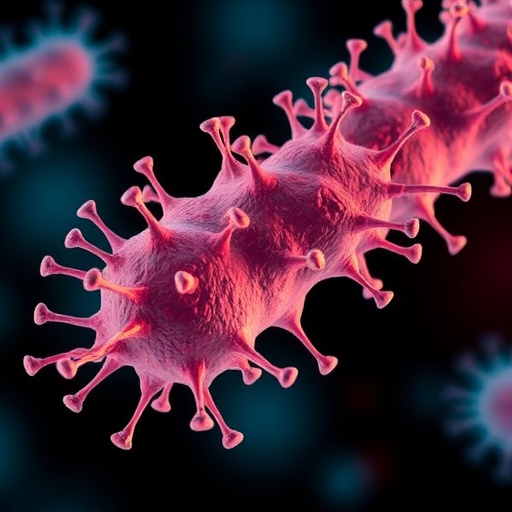In a groundbreaking advancement poised to redefine our understanding of microbial life, researchers from the Hebrew University of Jerusalem have uncovered a remarkable phenomenon: individual bacterial cells possess a form of “memory” that can be transmitted across multiple generations. This incredible discovery, spearheaded by Dr. Raya Faigenbaum-Romm and supervised by Professor Nathalie Q. Balaban, demonstrates that bacteria are far from the uniform, instantaneous responders biology once presumed. Instead, these microorganisms carry an inherited phenotypic memory from their previous environments, which can influence their behavior and survival in profound ways.
Traditionally, microbiologists have treated bacterial populations as homogeneous collections of genetically identical cells, with differences in behavior attributed mainly to random fluctuations or genetic mutations. However, the reality is far more nuanced. While it is known that genetically identical bacteria can exhibit diverse behaviors—some growing rapidly, others adopting survival tactics—until now, the mechanisms enabling such diversity and persistence within clones remained elusive. By developing a novel method termed Microcolony-seq, Dr. Faigenbaum-Romm and her team have provided the first empirical evidence of bacterial phenotypic inheritance, fundamentally shifting how we understand bacterial individuality and adaptability.
Microcolony-seq exploits the power of isolating minuscule colonies derived from single bacterial cells. Unlike existing single-cell RNA sequencing techniques, which often suffer from biological noise and technical limitations, this innovative approach analyzes entire microcolonies to capture a more stable and informative snapshot of cellular states. By simultaneously interrogating transcriptomic patterns, genomic sequences, and physical phenotypes within these nascent colonies, the researchers can discern whether observed differences stem from genetic mutations or from inheritable, epigenetic-like phenotypic states.
The team applied Microcolony-seq to common yet clinically significant pathogens—including Escherichia coli and Staphylococcus aureus—and uncovered an extraordinary landscape of intra-population heterogeneity. Remarkably, individual infections comprise intricate mosaics of subpopulations, each defined by distinct survival strategies and virulence profiles. Some bacterial lineages activate sets of genes that enable them to firmly adhere to host tissues, enhancing colonization and immune evasion, while others prime themselves for motility or endurance under hostile conditions such as antibiotic stress. These findings highlight a dynamic bacterial “coalition,” a diversified community within seemingly single-strain infections.
One of the most striking revelations is the duration over which this microbial memory endures. Dr. Faigenbaum-Romm explains that the phenotypic states inherited by daughter cells can persist for upwards of twenty generations, creating stable subpopulations that shape infection trajectories and bacterial responses. Nevertheless, this memory is not permanent. The study highlights that when bacteria enter the stationary phase—triggered by nutrient exhaustion—the memory effectively resets, erasing prior phenotypic distinctions and homogenizing the population once again. This temporal limit underscores the adaptive balance bacteria strike between maintaining advantageous traits and preparing for fluctuating environments.
The clinical consequences of these discoveries could be transformative. Conventional diagnostic methods often involve sampling a single bacterial colony to determine antibiotic susceptibility and virulence characteristics, a practice now understood to potentially overlook heterogeneity within infections. The Microcolony-seq findings suggest that missed subpopulations with distinct antibiotic resistance or virulence signatures could underlie frequent treatment failures or relapses. Prof. Balaban emphasizes that addressing infections requires a paradigm shift—from targeting a presumed uniform pathogen to confronting a multifaceted, resilient bacterial consortium.
Furthermore, the implications for vaccine development are profound. Many experimental vaccines against S. aureus and other pathogens have faltered in clinical trials, a failure possibly attributable to their focus on singular bacterial phenotypes. By revealing the coexistence of multiple stable and distinct bacterial subpopulations within infections, this research provides a plausible explanation for such setbacks and points toward the necessity of designing multi-targeted or adaptable therapeutic strategies that reflect bacterial diversity.
Beyond immediate clinical impact, Microcolony-seq paves the way for a new era in microbial research. With the ability to systematically map phenotypic inheritance and evolution within single-cell derived colonies, scientists can probe how bacterial populations diversify, strategically hedge their bets against environmental uncertainty, and rapidly adapt. This method holds promise not only for pathogens but also for studying commensal microbes in the gut microbiome, fungal pathogens, and industrially important fermentation processes, where understanding population dynamics at high resolution is essential.
Notably, the study challenges long-held assumptions about bacterial simplicity. Instead of “mindless” microbes reacting in real time, bacteria emerge as historical entities—each single cell carrying a story embedded in its inherited phenotypic state. This memory influences future behavior and survival outcomes, effectively granting bacteria a kind of cellular “history” that shapes infection progression and response to treatments. It is a conceptual leap that could lead to more precise diagnostics and interventions.
Technically, Microcolony-seq integrates cutting-edge sequencing technologies with innovative colony isolation and analysis pipelines. The researchers developed meticulous protocols to cultivate microcolonies, ensuring minimal disturbance to natural cellular states. High-resolution RNA sequencing enables differentiation between genetic and epigenetic contributions to phenotypic variability. This system also allows quantitative assessment of gene expression stability across generations and tracks how environmental cues modulate the inheritance patterns.
The discovery was published in the prestigious journal Cell, under the title “Uncovering Phenotypic Inheritance from Single-Cells with Microcolony-seq.” The article, which appeared on August 26, 2025, represents a landmark contribution to cell biology and microbiology. By combining experimental rigor with novel theoretical frameworks, the study illuminates the hidden complexity within pathogenic populations and offers actionable insights for better therapeutic targeting.
In essence, Microcolony-seq does more than just measure bacterial gene expression; it opens a window into the temporal dynamics of phenotypic inheritance—a dimension previously invisible to science. This newfound ability to decode microbial memory holds transformative potential, impacting how we understand infection biology, resistance evolution, and microbial ecology. As Dr. Faigenbaum-Romm aptly summarizes, “We’ve been treating bacteria as if they’re all the same, but in reality, even a single cell carries a story of its past. Microcolony-seq lets us finally read that story.”
Subject of Research: Cells
Article Title: Uncovering Phenotypic Inheritance from Single-Cells with Microcolony-seq
News Publication Date: 26-Aug-2025
Web References: DOI 10.1016/j.cell.2025.08.001
Keywords: Cells, Pathogens, Bacteria




